Who's Online
We have 194 guests and no members online
Almost complete games
Here you'll find the rules of additional abstract games invented by Christian Freeling ◆ ordered on theme. Most of these can be played in the Pit, and free downloadable applets are provided to store the games offline.
◆ Hexemergo and Chakra invented by Christian Freeling and Ed van Zon.
◆ YvY invented by Christian Freeling and David J. Bush.
◆ HanniBall invented by Christian Freeling and Arty Sandler.
All applets are by Ed van Zon.
Chess variants
The theme checkmate is existential to the core: the king must die. There exist hundreds, if not thousands, of chess variants because, unfortunately, it's very easy to make one that 'works'.
Shakti
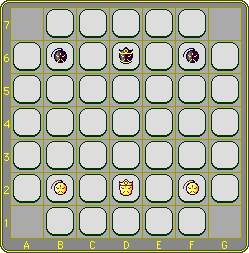 | This is without doubt the smallest chess game with a non trivial strategy. In the initial position the board is covered with 45 tiles. During play this number is bound to be reduced due to the 'atlantis effect', a mechanism that lies at the core of this miniature, and without which no such reduction in material would ever be possible.
|
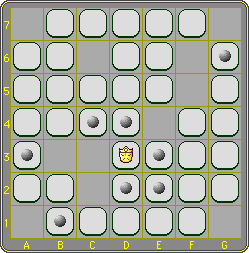 |
|
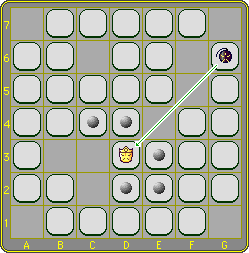 |
|
 | The mutual check rule:
|
 | The Warrior:
|
External links
- ig Game Center (live play)Scroll down to play @ iG Game Center
- A Shakti program for the MacA free downloadable Mac program by Joe Strout.
- Shakti @ The Chess Variant Pages
- Shakti's entry @ BoardGameGeek
Shakti © MindSports
Java applet © Ed van Zon
Caïssa
 | Caïssa employs a different implementation of the 'atlantis effect'. On top of that, Caïssa introduces another absolute novelty: 'capture by exchange', which is in fact no capture at all. In the initial position the board is covered with 49 tiles.
|
 | The Queen The king's role is played by the queen. The diagram on the left shows its options for movement and capture in a non-check situation. |
 | If in check, it is restricted to adjacent squares, as shown in the diagram on the right. Thus pieces giving check from a distance, need no cover. The queen is the only piece with the power of capture in the usual sense. The atlantis effect If the queen moves, the tile it vacates is removed in the same turn. The removal is compulsory, but it may not violate the tile-connection rule. The mutual check rule Queens may not see one another along the same rank, file or diagonal, so neither player may effectuate that situation. Thus a Queen may protect a piece against capture by it's counterpart. |
 | The pieces move as in Chess. Under the implicit condition of not putting its own queen in check and the explicit condition of not violating the connection rule, a piece can always move to any of its target-squares, whether or not it is tiled, and if it is, whether or not it is occupied, and if it is, regardless of the color of the occupying piece!
|
 | About tile-surfing and the connection rule This 'mate in 1' shows another application of tile-surfing and the connection rule. For clarity all other pieces have been omitted. After d2c4, the queen cannot move because the tile on c1 would be disconnected. If black were able to exchange the knight on c4 immediately with any of his pieces, he could yet prevent the mate, but the queen would remain immobile until one of black's pieces would bring a tile to the rescue. |
Applet
download applet play online a word on notation |
You can download this MindSports applet, which is tailored to save games played in the Pit, offline. |
External links
- Caïssa @ ZillionsCaïssa has been implemented on the Zillions game machine.
- Caïssa @ The Chess Variant Pages
- In the 2003 CodeClub Challenge, Caïssa was subject of the annual game programming contest in the Netherlands.
Caïssa © MindSports
Java applet © Ed van Zon
Chad
 | The diagram shows the Chad board with the pieces in the initial position. The areas covered by the pieces are called the castles Each castle has twelve adjacent squares that together constitute the wall.
|
-
The rook moves like the rook in Chess, unhindered by castles and walls.
If it ends its move inside the opponent's castle, it is promoted to queen.
The queen moves as the queen in Chess, unhindered by castles and walls -
The mutual right of capture exists, and only exists, between an attacking piece on the wall and a defending piece inside the castle.
Apart from this situation pieces simply block one another.
This is a crucial rule! It is illustrated in the next diagram. Black's castle shows a rook on the wall facing a defender inside. In such a situation both have the right to capture. However, in this specific situation only white can capture because the black rook is pinned! This position shows one of the basics of attack.
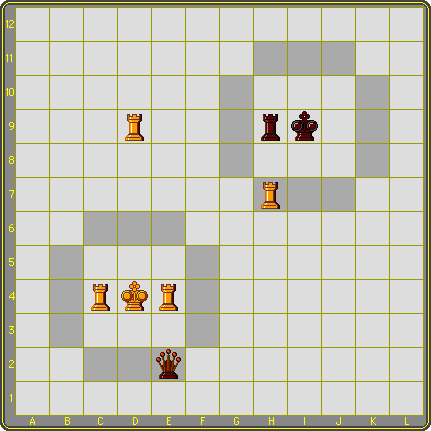 |
If it were white's turn he could checkmate in two, so let's assume it's black's turn. Let's also disregard the other pieces for a moment and assume the postion around black's castle is part of an actual position. What can black do? Interposing a piece on any of the squares between the black rook and either of the white rooks, would parry the immediate threat. If this isn't possible, black's only option is to move the defending rook towards the pinning one. But this leaves a white rook on the wall attacking three squares inside the castle - literally a thorn in white's side. Needless to say that the white rooks illustrate a basic attacking pattern. It appears in a variety of forms in almost all attacking concepts. |
A related basic concept is the promotion sacrifice. It derives from the fact that an attacker, once it is inside the castle (and thus automatically a queen), can only be captured by the king.
A king on the side leaves one square unprotected, and a king in the corner three. The sacrifice of a piece to force the king to the side or into the corner, to clear the way for a second piece to promote on an unprotected square, is very common.
A queen is worth the sacrifice of a piece anytime! Its strength is illustrated in the same diagram: if it were black's move, the lone queen could checkmate the white king in just two moves.
In positional respect, a rook on a square diagonally adjacent to the enemy castle covers two segments of the wall. Needless to say these spots are popular. Finally, every attack eventually draws from defending forces, so an attack to checkmate should drive home. If it fails, 3-fold is one's only hope!
Applet
download applet play online a word on notation | You can download this MindSports applet, which is tailored to save games played in the Pit, offline. |
Chad was first published in 'The Gamer' (may-june 1982).
External links
- Chad @ ZillionsChad has been implemented on the Zillions game machine, as well as its hexagonal version Zillions Hexchad.
- Chad @ The Chess Variant Pages
Chad © MindSports
Java applet © Ed van Zon
Rotary
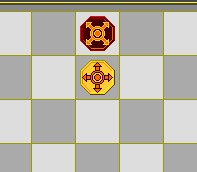 | The idea for Rotary came from Ploy, a proprietary game (3M) in the seventies. In this game the number of directions a piece could choose from, also determined its maximum range. This had two major drawbacks: first of all the limited and different ranges of the pieces did put a strain on clarity. A simple look at the directions was not enough: one constantly had to check the different ranges. The second flaw was even worse. By increasing the range with the number of directions, the strong pieces became even stronger, the weak even weaker. Moreover, three pieces of pathetic weakness - one step in one possible direction - were outnumbered by six very strong pieces, each able to go up to three steps in three possible directions. |
Although the weak ones were compensated by their right to rotate in the same turn, I've seldom seen a better example of internal imbalance in a game. But I also saw the possibility of a complete and consistent set of long-range pieces, to provide for clarity, separated by very orthodox pawns, to bring at least some strategy to a system of capricious tactics.
 | Once the idea was there, implementation was simple.
|
The pieces follow a logical sequence. All are subject to the following rules:
- A piece may, at the cost of a turn, rotate on its place, provided this effectuates a change in orientation.
- A piece may move one square in any of its directions and rotate, but only after the move, as part of the same turn.
- A piece may move any distance in any of its directions, but if it moves more than one square, it loses the right to rotate in the same turn. The only exception is the Scythe that has the right to rotate in the same turn regardless of the length of its move.
|
Strategy
The strategic implications of the pawn structure differ little from Chess. Apart from this, it is difficult calculate deep in the game's rather capricious tactics, and in consequence also to make a specific overall plan.
The pieces are of roughly equal strength, but differ rather dramatically in timing. The forward oriented Axe, for instance, has no immediate possibility for retreat, so its encounter with an opponent's pawn structure should be avoided. The Axe usually becomes active in the later stages of the game when the number of pawns has reached saver levels.
The Rook, to a lesser degree, encounters the same problems. The best orientation is usually with its middle direction obliquely forward or even sideways, to ensure the possibility of a retreat.
The Trident can be brought into play in an earlier stage. Its directions are rather roundabout ensuring a greater flexibility.
The Scythe is the opening piece par excellence. Its greatest joy is penetrating behind the opponent's pawn structure and finding the pieces, from its opponent's point of view, in precisely the wrong orientation. The amount of havoc a Scythe can create in these circumstances is unbelievable!
External links
- Rotary @ ZillionsRotary has been implemented on the Zillions game machine.
- Jogre - realtime playJogre (Java Online Gaming Real-time Engine) will feature Rotary soon.
- Rotary @ BoardGameGeek - Forum
Rotary © MindSports
No applet
Loonybird
 | Pawns move and capture in different ways. One night I thought 'what if in a chess game ALL pieces except the king would move and capture in different ways' ? In what was very much the same moment I saw that the three basic pieces, rook, bishop and knight, gave rise to six combinations. These consist of a top-piece called the hunter which constitutes the way the piece captures and a bottom-piece called the carrier, which constitutes the way the piece moves. Of course only hunters can give check, therefore a piece is called after its hunter. I immediately decided for piece drops to avoid the possibility of a drawish system. As an afterthought came the concept of Dragonfly which may be considered as 'normal Loonybird'. Thus I had two new games within a couple of minutes. |
The diagram shows the board with the pieces in the initial position.
- The nature of the pieces has been explained, but for the option to re-enter them.
If a piece is captured, it becomes the captor's property, and he may drop it, at the cost of a turn, on any square. As in all systems that feature the re-entering of pieces, this is called a 'piece in hand'.
The applet takes care of the switch. - Pawns are chess pawns, but do not have the initial double step. They promote on moving to the seventh rank to a piece the opponent has 'in hand'. This makes promotion exceptionally strong and, if all pieces are on the board, well worth even the worst exchange, say a rook for the bishop-knight, to force an opponent into a piece in hand.
Pawns, if captured, are out of the game. - The king is the same as in Chess but there is no 'castling'.
Anonymous#1 - Anonymous#2
| download applet play online a word on notation | You can download this MindSports applet, which is tailored to save games played in the Pit, offline. |
Note: Loonybird has been implemented on the Zillions game machine.
External links
- Loonybird @ ZillionsLoonybird has been implemented on the Zillions game machine.
Loonybird © MindSports
Java applet © Ed van Zon
Elimination
The theme elimination is existential: one must die lest two must suffer the insufferable draw. There's hardly a culture that has not implemented the basic idea of pitting two armies of uniform men against one another on a game board.
